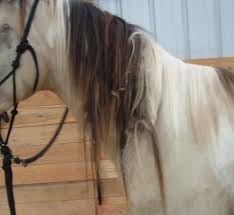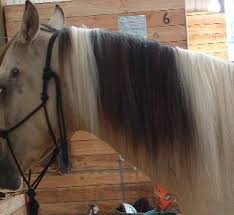 When he arrived his mane was dread-locked, his body covered in numerous flesh wounds and his knees were skinned. The beautiful buckskin paint Arab had just been gelded at the age of 5, only two weeks before coming to my place for training, (that explained the skinned knees). Frightened and angry, ears pinned and hooves overgrown he was very unhappy. His owner wanted him started under saddle with trail training for which I require a minimum of 120 days, but she added two extra months because “Star may need it” she said. “Hmm, maybe he
When he arrived his mane was dread-locked, his body covered in numerous flesh wounds and his knees were skinned. The beautiful buckskin paint Arab had just been gelded at the age of 5, only two weeks before coming to my place for training, (that explained the skinned knees). Frightened and angry, ears pinned and hooves overgrown he was very unhappy. His owner wanted him started under saddle with trail training for which I require a minimum of 120 days, but she added two extra months because “Star may need it” she said. “Hmm, maybe he  will maybe not” I thought. I’ve had horses here that I started under saddle, finished with trail training and sent home in 75 days, so we’ll see.
will maybe not” I thought. I’ve had horses here that I started under saddle, finished with trail training and sent home in 75 days, so we’ll see.
My first session with Star was spent untangling his mane for an hour. Typically my first session with a horse is a Wholistic Joining to invoke their natural instinct to recognize me as their herd leader, but this guy seemed to need touch and gentleness before I began moving his feet GHT#1 (Gentle Horsemanship Tip).
GH Tip #1 – “Speaking the Language – Herd Psychology”; He who moves the other’s feet first is in control.
Star’s high head began to lower and his worry melted away as I brushed and cooed over him. I touched and rubbed him gently all over looking for “issue” areas and found under the belly, flank and general rear area (indeed he was just gelded) were his problem spots. He had obvious foot handling issues too which explained the overgrown feet, so I did some touch and retreat GHT#2 around each leg. I scrubbed Star’s wounds with Natures Balance Care (NBC) Groomer and applied NBC Bare Skin Barrier to keep the flies and insects off while it accelerated the healing. He seemed content to be cared for and quietly accepted a carrot as I put him back in his paddock. Note: I only give treats after a session and use carrots for chiropractic stretching. I do not use treats to train; I want a partnership, not a circus animal.
GH Tip #2 – Touch Retreat. If a horse doesn’t want to be touched in certain areas, for example the ears, rub in areas close to the ears and then touch the ear quickly and retreat as if you were never there. Continue to do this until the horse stops noticing and accepts being touched in that area.
Wholistic Joining:
The next day I did a Wholistic Joining in a 60 x 96 training arena. He floated over the arena floor in a beautiful natural pace with his tail flagged and ears forward, a majestic sight showing his stallionesque beauty for all to see. The Wholistic Joining took about 30 minutes for Star for his instinct to kick in and recognize me as his herd leader. However he didn’t stay latched on to me for very long the first attempt, so I ran him off (GH Tip #1 above: he who moves the other’s feet first is in control), but he never kicked out as so often many horses do sassing the lead mare, “me”. I gave him more time at liberty watching for signs of submission GHT#3.
GH Tip #3 – Signs of submission: first, I want to see his inside ear back which says he is paying attention to me; lowering his head and licking his lips is a sign of submission and indication he’s beginning to understand that I’m the leader; second, when I ask him to change direction he turns into me not away from me; third, he will start mowing the ground by lowering his head almost touching the ground as he is moving at a walk or trot.
Once Star began “mowing the ground” in submission he was ready to connect with me as his herd leader so I stepped in front of his drive line GHT#4 and he turned to look at me. Instantly I dropped my pressure GHT#5 by lowering my eyes and turning my shoulder to him, and I said “good boy”. I walked up slowly with an outstretched hand, shoulder turned not making eye contact and rubbed his face. I tickled under his chin as I moved to his shoulder and yielded his hind quarters while he followed my outstretched hand. As I got his feet moving we made bigger circles until he was following me in a forward direction quietly with his head relaxed. After a moment of forward movement I stopped and loved him up while I put his halter on. Now Star was ready to be assessed and begin his training.
GH Tip #4 – Drive Line. The drive line is the area from the girth forward. To step in front of the drive line I simply take one step to the side without moving my other foot. This is a step in front of the drive line and a signal to the horse to stop and turn to me. Once a horse turns and looks at me when I step in front of the drive line I immediately drop my pressure, i.e. drop my eye contact, my countenance, turn my shoulder to him and say “good boy”. The horse has an “aha” moment and realizes he answered correctly.
GH Tip #5 – Pressure & Release. A horse learns from the release of pressure, not the pressure itself. Your release of pressure must be instant; as crisp as can be in order for the horse to learn he made the right choice. Always use a rope halter when training along with a 12’ – 14’ lead rope. The rope halter applies appropriate pressure compared to a web halter. I do everything from training to riding, even stallions, in an All-In-One Bitless Bridle. The All-In-One is a rope halter first then converts to a bitless bridle by snapping on a set of reins to the side-pull loops.
GH Tip #6 – Stick & String. I prefer to use a training stick & string as an extension of my hand. If I can touch the horse with the stick while lunging the horse is too close and I’m vulnerable to a kick. Once I know a horse well enough a training session will consist of “forward and around & circle driving” which is bringing the horse closer to me and actually having the stick on their back as a desensitizing lesson. But, when first working with a new horse they must be out of stick range. Also, if a horse were to charge me the stick is firm enough to reprimand on the shoulder to avoid getting run over – a lunge whip is too flexible so I don’t use them. Always desensitize a horse to the training stick as well as sensitize.
Backing Up:
When I assess a horse the first thing I want to know is can he back up. My space is privileged and a horse is not allowed into my space without invitation. Therefore teach a horse to back up is important for keeping a safe distance and showing respect.
I stood in front of Star with the lead rope in one hand and my stick in the other. I gently jiggled the lead rope and asked “back”, but he just stood there. I began increasing the pressure by jiggling the rope harder and harder as I walked toward him, my eyes fixed on his which is pressure to a horse, but he threw his head up and stood his ground. I began waving the stick under the lead rope and he instantly took a step back. “Good boy” I said releasing the pressure by instantly stopping all the jiggling, waving, walking and dropping my countenance and eye contact. If Star had not moved back I would have simply walked up and pulled firmly on the shank under his chin and backed him up.
I asked Star again to back up with a gentle jiggle of the rope, no response. I jiggled harder, eyes fixed on his, no change. So I started walking into him with determination in my body’s countenance and “voila”, he took a step back “Good boy” I exclaimed! He soon started backing with just a slight jiggle of the lead rope – “Good boy”!! I gave Star carrot stretches and put him away for the day to soak GHT#7.
GH Tip #7 – Soaking Time. As soon as your horse “gets it” quit for the day. The long way is the short way with Gentle Horsemanship. Nerve endings in the brain cells called dendrites continue to work making new neuro-connections while at rest. Have you ever noticed when you come back to your horse a day or so later he often is further along in his training from where you left off? That is because he had time to “soak”. A horse’s brain made new connections while at rest. It is important to stop, and put him away when he “gets it” no matter what “it” is that you are teaching him, give him time to “soak”. You will be amazed how quickly he learns and retains the training.
GH Tip #8 – Black & White Zone. You’ve got to make training black and white for your horse. The white zone is nice and loving. The black zone is uncomfortable. Make the right thing easy and the wrong thing uncomfortable. Be very clear about what you are asking. Increase the pressure until you get the right answer then immediately drop your pressure and make it a nice place to be in the white zone – lots of “good boy”, “good girl”. I like to verbalize because it reinforces my overall body language – horses read body language.
GH Tip #9 – Always end on a good note. If things are going badly, go back to something you know your horse is successful at and end on that success before you become frustrated and lose your temper. Come back later when you are in a better frame of mind. Always end the session at a place in training where both you and your horse feel good about the last moments.
Follow Missy’s progress as she starts this stallionesque gelding under saddle and discovers pain issues and possible ulcers. Part 2 (available tomorrow) & Part 3 (available Wednesday)
Internationally recognized Gentle Horse Trainer and member of the Association of Professional Humane Educators, Missy Wryn provides comprehensive horse training, horse management, and effective communication workshops, clinics, and presentations across the globe and at her Zen Barn in Estacada, Oregon. For more information visit Missy Wryn’s website at MissyWryn.com or call toll free (888) 406-7689.
Specializing in problem and dangerous horses Missy Wryn is an internationally recognized Gentle Horse Trainer and member of the Association of Professional Humane Educators. Missy’s Training the Whole Horse® methods & techniques and the creation of her widely popular All-In-One Bitless Bridle have been featured in media such as Alaska Airlines Magazine, NW Horse Source, Stable Management, Trail Ride Magazine and more. For more information visit Missy’s website at MissyWryn.com or call toll free (888) 406-7689.




